check engine light Ram 5500 Chassis Cab 2011 User Guide
[x] Cancel search | Manufacturer: RAM, Model Year: 2011, Model line: 5500 Chassis Cab, Model: Ram 5500 Chassis Cab 2011Pages: 476, PDF Size: 7.32 MB
Page 203 of 476
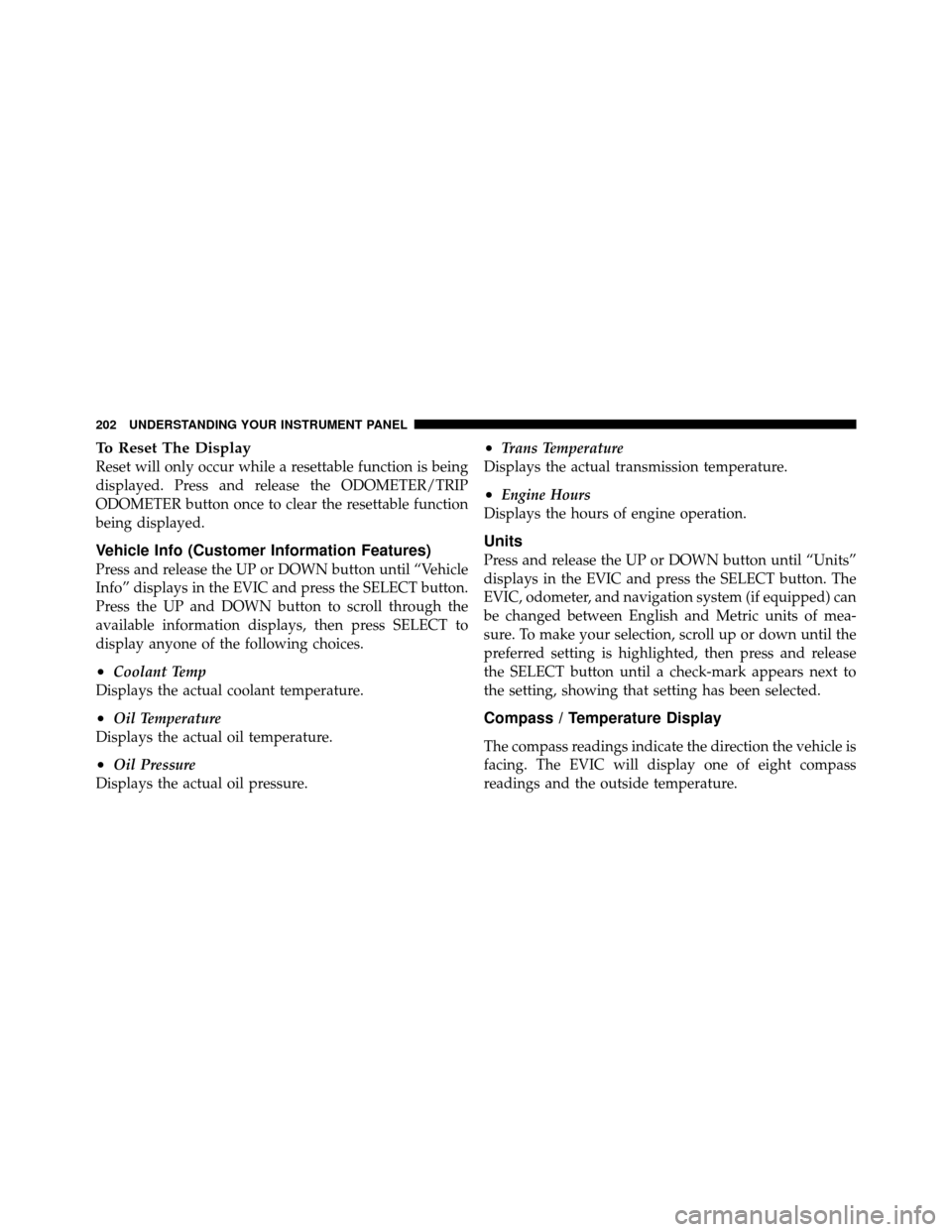
To Reset The Display
Reset will only occur while a resettable function is being
displayed. Press and release the ODOMETER/TRIP
ODOMETER button once to clear the resettable function
being displayed.
Vehicle Info (Customer Information Features)
Press and release the UP or DOWN button until “Vehicle
Info” displays in the EVIC and press the SELECT button.
Press the UP and DOWN button to scroll through the
available information displays, then press SELECT to
display anyone of the following choices.
•Coolant Temp
Displays the actual coolant temperature.
•Oil Temperature
Displays the actual oil temperature.
•Oil Pressure
Displays the actual oil pressure.
•Trans Temperature
Displays the actual transmission temperature.
•Engine Hours
Displays the hours of engine operation.
Units
Press and release the UP or DOWN button until “Units”
displays in the EVIC and press the SELECT button. The
EVIC, odometer, and navigation system (if equipped) can
be changed between English and Metric units of mea-
sure. To make your selection, scroll up or down until the
preferred setting is highlighted, then press and release
the SELECT button until a check-mark appears next to
the setting, showing that setting has been selected.
Compass / Temperature Display
The compass readings indicate the direction the vehicle is
facing. The EVIC will display one of eight compass
readings and the outside temperature.
202 UNDERSTANDING YOUR INSTRUMENT PANEL
Page 322 of 476
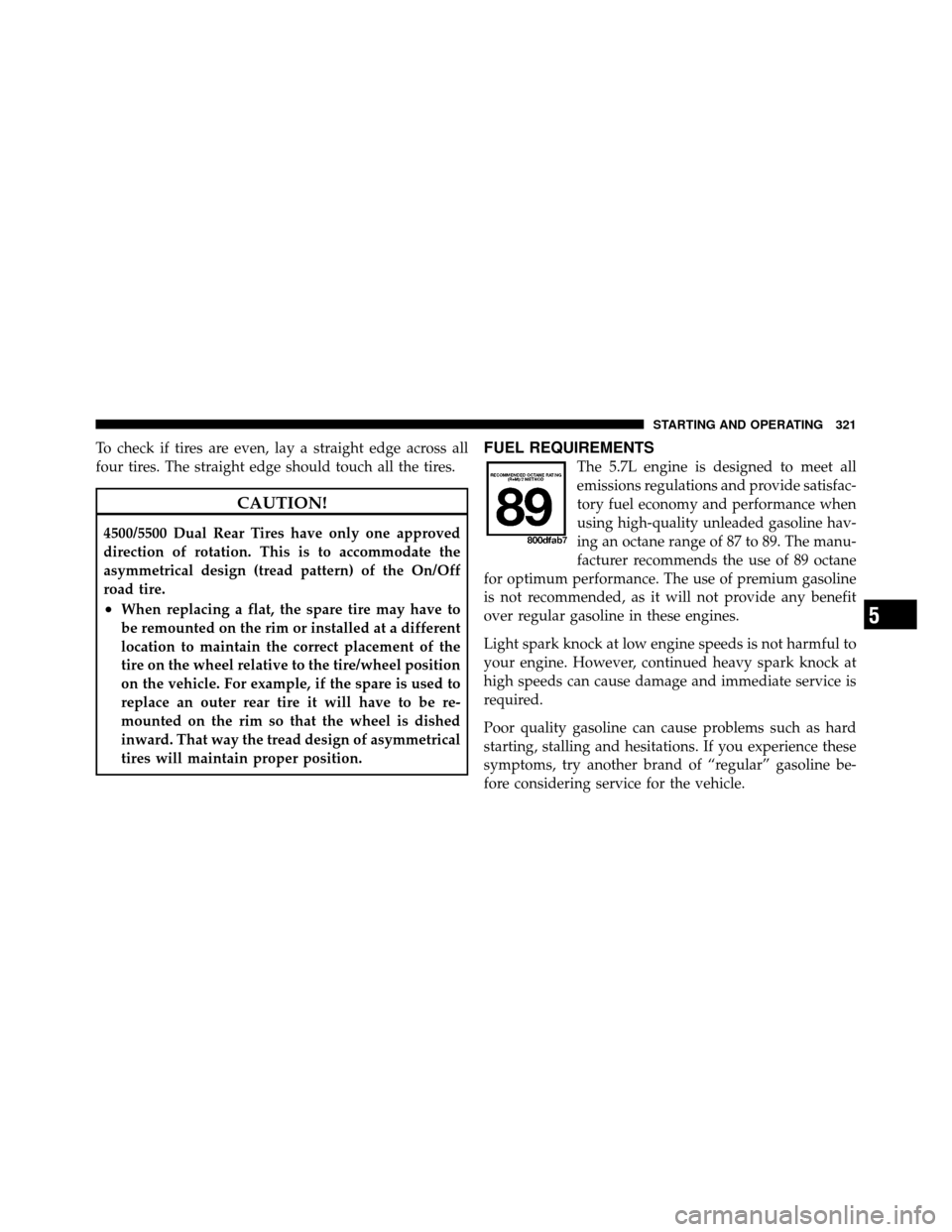
To check if tires are even, lay a straight edge across all
four tires. The straight edge should touch all the tires.
CAUTION!
4500/5500 Dual Rear Tires have only one approved
direction of rotation. This is to accommodate the
asymmetrical design (tread pattern) of the On/Off
road tire.
•When replacing a flat, the spare tire may have to
be remounted on the rim or installed at a different
location to maintain the correct placement of the
tire on the wheel relative to the tire/wheel position
on the vehicle. For example, if the spare is used to
replace an outer rear tire it will have to be re-
mounted on the rim so that the wheel is dished
inward. That way the tread design of asymmetrical
tires will maintain proper position.
FUEL REQUIREMENTS
The 5.7L engine is designed to meet all
emissions regulations and provide satisfac-
tory fuel economy and performance when
using high-quality unleaded gasoline hav-
ing an octane range of 87 to 89. The manu-
facturer recommends the use of 89 octane
for optimum performance. The use of premium gasoline
is not recommended, as it will not provide any benefit
over regular gasoline in these engines.
Light spark knock at low engine speeds is not harmful to
your engine. However, continued heavy spark knock at
high speeds can cause damage and immediate service is
required.
Poor quality gasoline can cause problems such as hard
starting, stalling and hesitations. If you experience these
symptoms, try another brand of “regular” gasoline be-
fore considering service for the vehicle.
5
STARTING AND OPERATING 321
Page 344 of 476
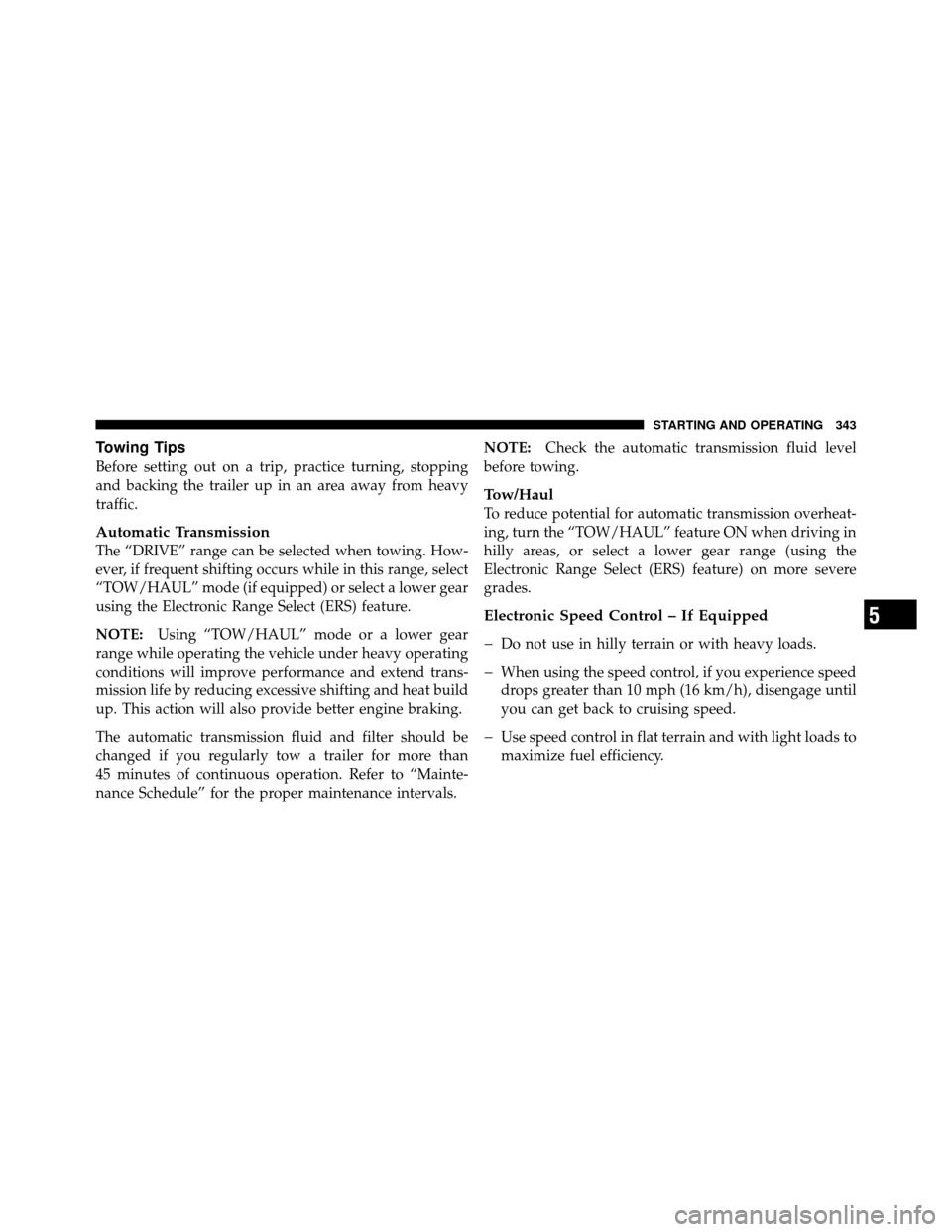
Towing Tips
Before setting out on a trip, practice turning, stopping
and backing the trailer up in an area away from heavy
traffic.
Automatic Transmission
The “DRIVE” range can be selected when towing. How-
ever, if frequent shifting occurs while in this range, select
“TOW/HAUL” mode (if equipped) or select a lower gear
using the Electronic Range Select (ERS) feature.
NOTE:Using “TOW/HAUL” mode or a lower gear
range while operating the vehicle under heavy operating
conditions will improve performance and extend trans-
mission life by reducing excessive shifting and heat build
up. This action will also provide better engine braking.
The automatic transmission fluid and filter should be
changed if you regularly tow a trailer for more than
45 minutes of continuous operation. Refer to “Mainte-
nance Schedule” for the proper maintenance intervals. NOTE:
Check the automatic transmission fluid level
before towing.
Tow/Haul
To reduce potential for automatic transmission overheat-
ing, turn the “TOW/HAUL” feature ON when driving in
hilly areas, or select a lower gear range (using the
Electronic Range Select (ERS) feature) on more severe
grades.
Electronic Speed Control – If Equipped
�
Do not use in hilly terrain or with heavy loads.
�When using the speed control, if you experience speed
drops greater than 10 mph (16 km/h), disengage until
you can get back to cruising speed.
�Use speed control in flat terrain and with light loads to
maximize fuel efficiency.
5
STARTING AND OPERATING 343
Page 384 of 476
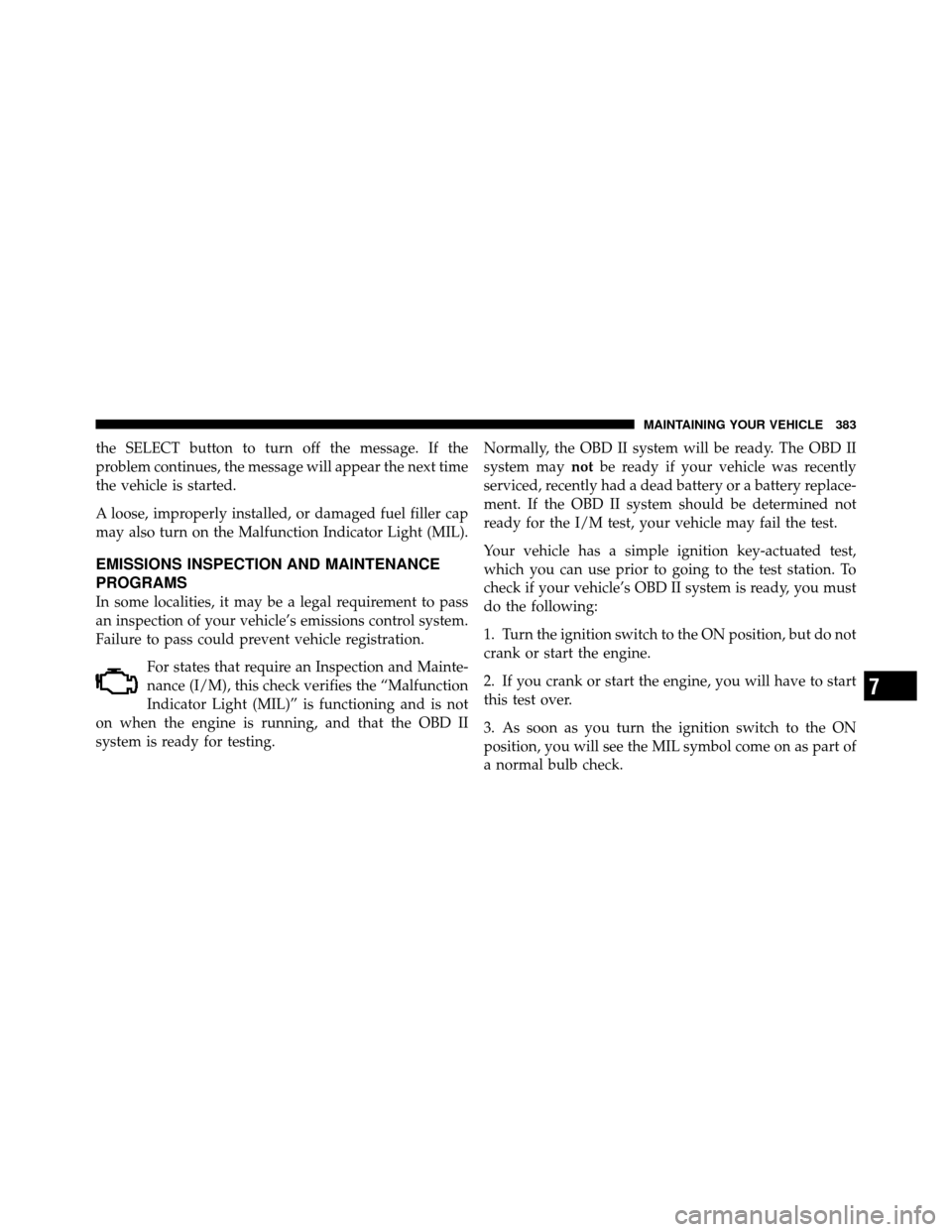
the SELECT button to turn off the message. If the
problem continues, the message will appear the next time
the vehicle is started.
A loose, improperly installed, or damaged fuel filler cap
may also turn on the Malfunction Indicator Light (MIL).
EMISSIONS INSPECTION AND MAINTENANCE
PROGRAMS
In some localities, it may be a legal requirement to pass
an inspection of your vehicle’s emissions control system.
Failure to pass could prevent vehicle registration.For states that require an Inspection and Mainte-
nance (I/M), this check verifies the “Malfunction
Indicator Light (MIL)” is functioning and is not
on when the engine is running, and that the OBD II
system is ready for testing. Normally, the OBD II system will be ready. The OBD II
system may
notbe ready if your vehicle was recently
serviced, recently had a dead battery or a battery replace-
ment. If the OBD II system should be determined not
ready for the I/M test, your vehicle may fail the test.
Your vehicle has a simple ignition key-actuated test,
which you can use prior to going to the test station. To
check if your vehicle’s OBD II system is ready, you must
do the following:
1. Turn the ignition switch to the ON position, but do not
crank or start the engine.
2. If you crank or start the engine, you will have to start
this test over.
3. As soon as you turn the ignition switch to the ON
position, you will see the MIL symbol come on as part of
a normal bulb check.
7
MAINTAINING YOUR VEHICLE 383
Page 394 of 476
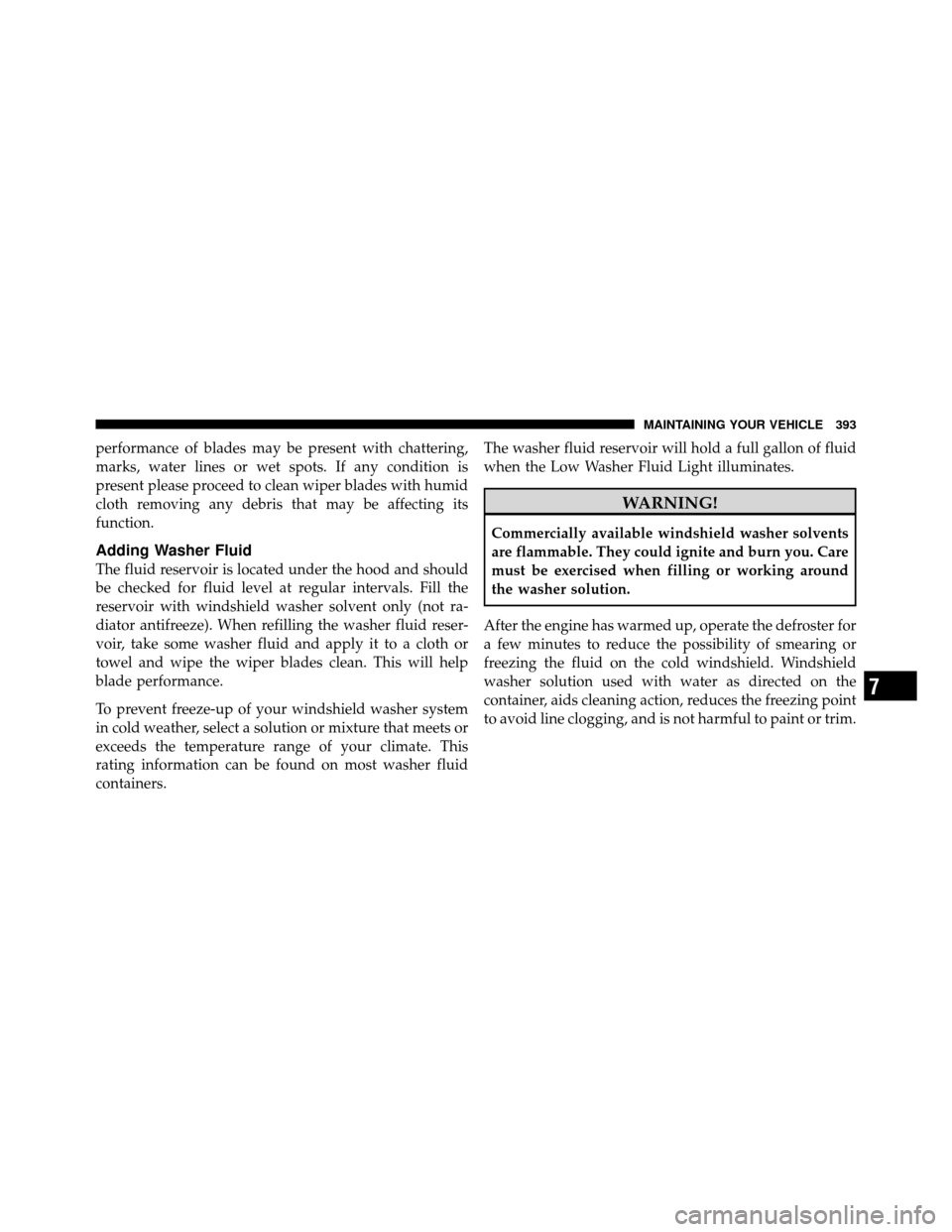
performance of blades may be present with chattering,
marks, water lines or wet spots. If any condition is
present please proceed to clean wiper blades with humid
cloth removing any debris that may be affecting its
function.
Adding Washer Fluid
The fluid reservoir is located under the hood and should
be checked for fluid level at regular intervals. Fill the
reservoir with windshield washer solvent only (not ra-
diator antifreeze). When refilling the washer fluid reser-
voir, take some washer fluid and apply it to a cloth or
towel and wipe the wiper blades clean. This will help
blade performance.
To prevent freeze-up of your windshield washer system
in cold weather, select a solution or mixture that meets or
exceeds the temperature range of your climate. This
rating information can be found on most washer fluid
containers.The washer fluid reservoir will hold a full gallon of fluid
when the Low Washer Fluid Light illuminates.
WARNING!
Commercially available windshield washer solvents
are flammable. They could ignite and burn you. Care
must be exercised when filling or working around
the washer solution.
After the engine has warmed up, operate the defroster for
a few minutes to reduce the possibility of smearing or
freezing the fluid on the cold windshield. Windshield
washer solution used with water as directed on the
container, aids cleaning action, reduces the freezing point
to avoid line clogging, and is not harmful to paint or trim.
7
MAINTAINING YOUR VEHICLE 393
Page 409 of 476
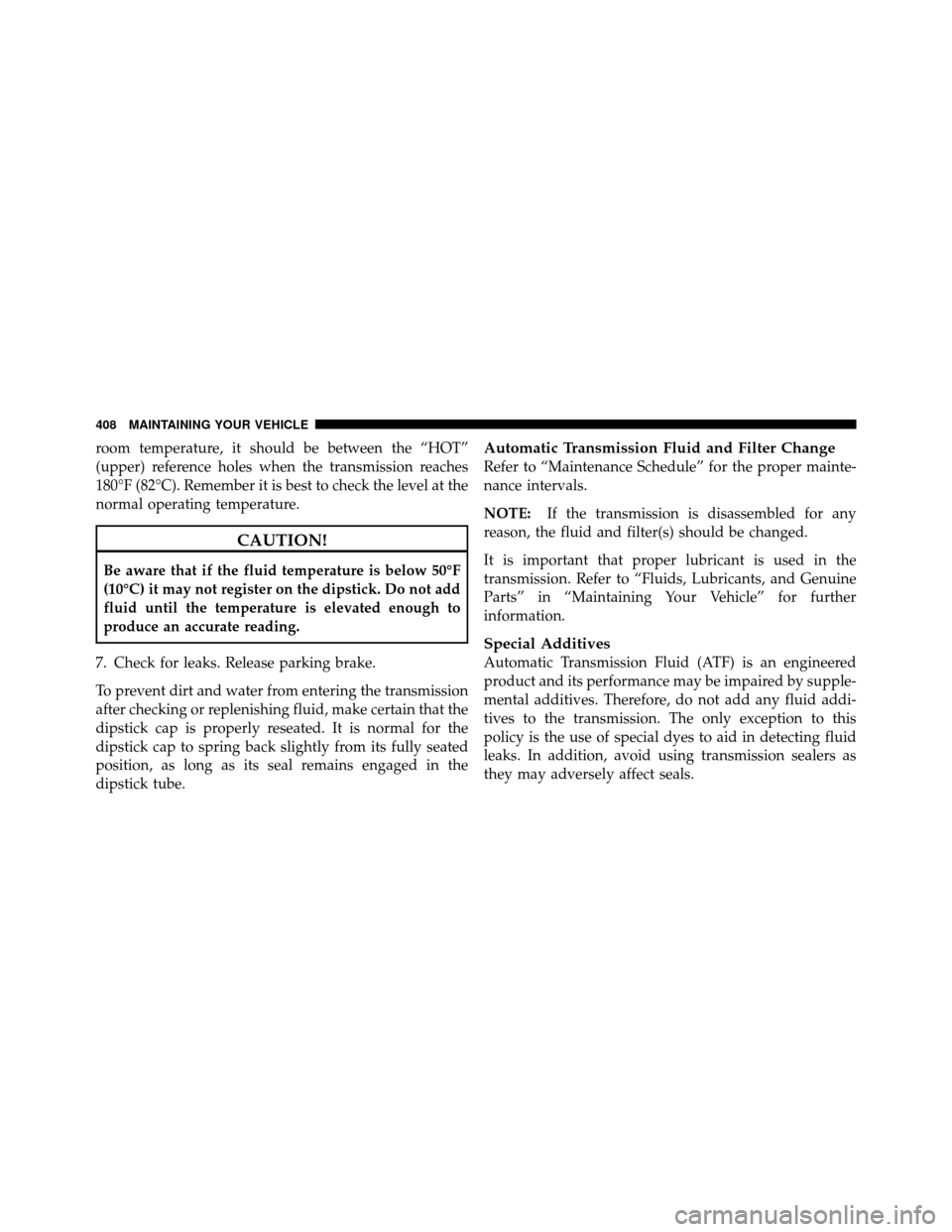
room temperature, it should be between the “HOT”
(upper) reference holes when the transmission reaches
180°F (82°C). Remember it is best to check the level at the
normal operating temperature.
CAUTION!
Be aware that if the fluid temperature is below 50°F
(10°C) it may not register on the dipstick. Do not add
fluid until the temperature is elevated enough to
produce an accurate reading.
7. Check for leaks. Release parking brake.
To prevent dirt and water from entering the transmission
after checking or replenishing fluid, make certain that the
dipstick cap is properly reseated. It is normal for the
dipstick cap to spring back slightly from its fully seated
position, as long as its seal remains engaged in the
dipstick tube.
Automatic Transmission Fluid and Filter Change
Refer to “Maintenance Schedule” for the proper mainte-
nance intervals.
NOTE: If the transmission is disassembled for any
reason, the fluid and filter(s) should be changed.
It is important that proper lubricant is used in the
transmission. Refer to “Fluids, Lubricants, and Genuine
Parts” in “Maintaining Your Vehicle” for further
information.
Special Additives
Automatic Transmission Fluid (ATF) is an engineered
product and its performance may be impaired by supple-
mental additives. Therefore, do not add any fluid addi-
tives to the transmission. The only exception to this
policy is the use of special dyes to aid in detecting fluid
leaks. In addition, avoid using transmission sealers as
they may adversely affect seals.
408 MAINTAINING YOUR VEHICLE
Page 433 of 476
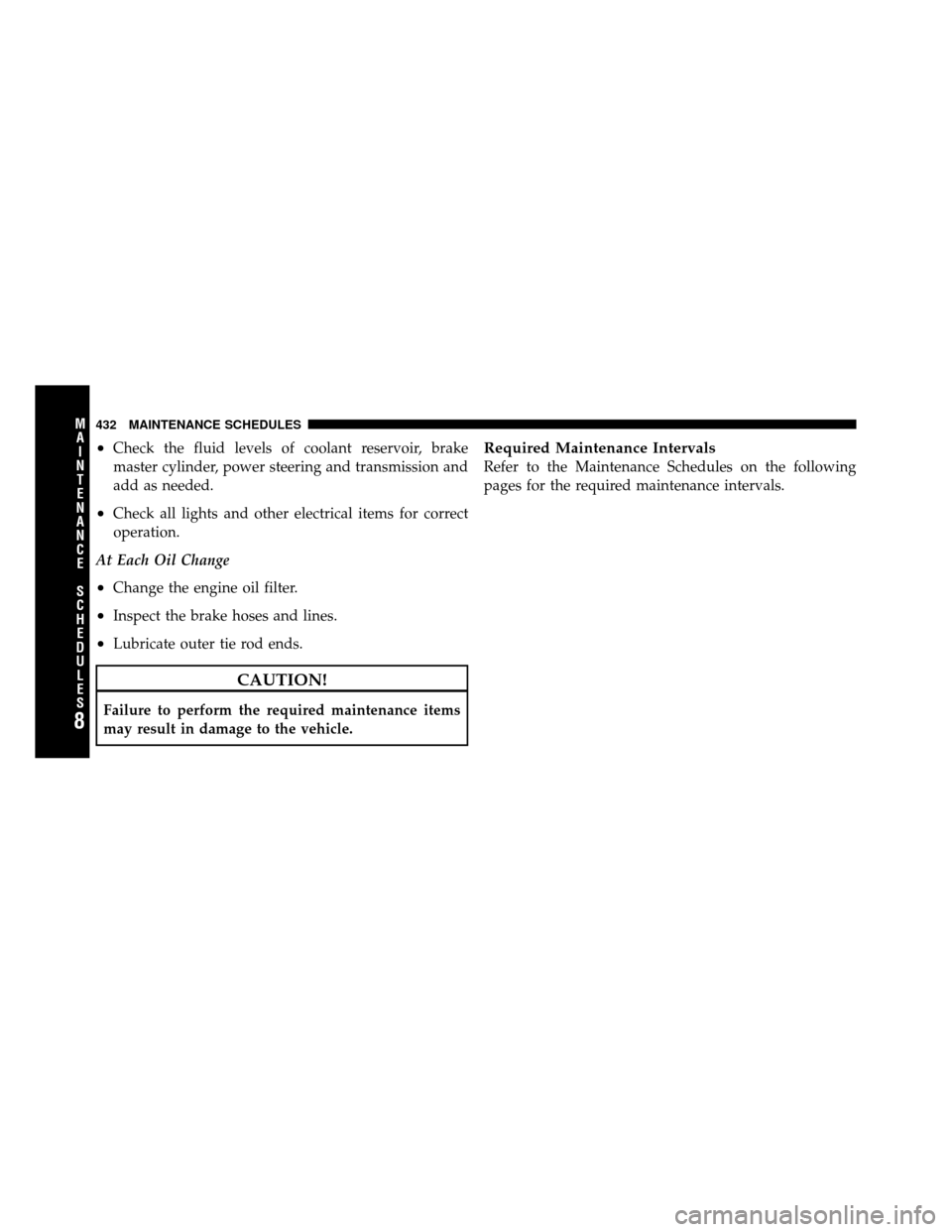
•Check the fluid levels of coolant reservoir, brake
master cylinder, power steering and transmission and
add as needed.
•Check all lights and other electrical items for correct
operation.
At Each Oil Change
•Change the engine oil filter.
•Inspect the brake hoses and lines.
•Lubricate outer tie rod ends.
CAUTION!
Failure to perform the required maintenance items
may result in damage to the vehicle.
Required Maintenance Intervals
Refer to the Maintenance Schedules on the following
pages for the required maintenance intervals.
8
M A I
N T
E
N A
N CE
S
C
H E
D
U L
E
S432 MAINTENANCE SCHEDULES
Page 460 of 476
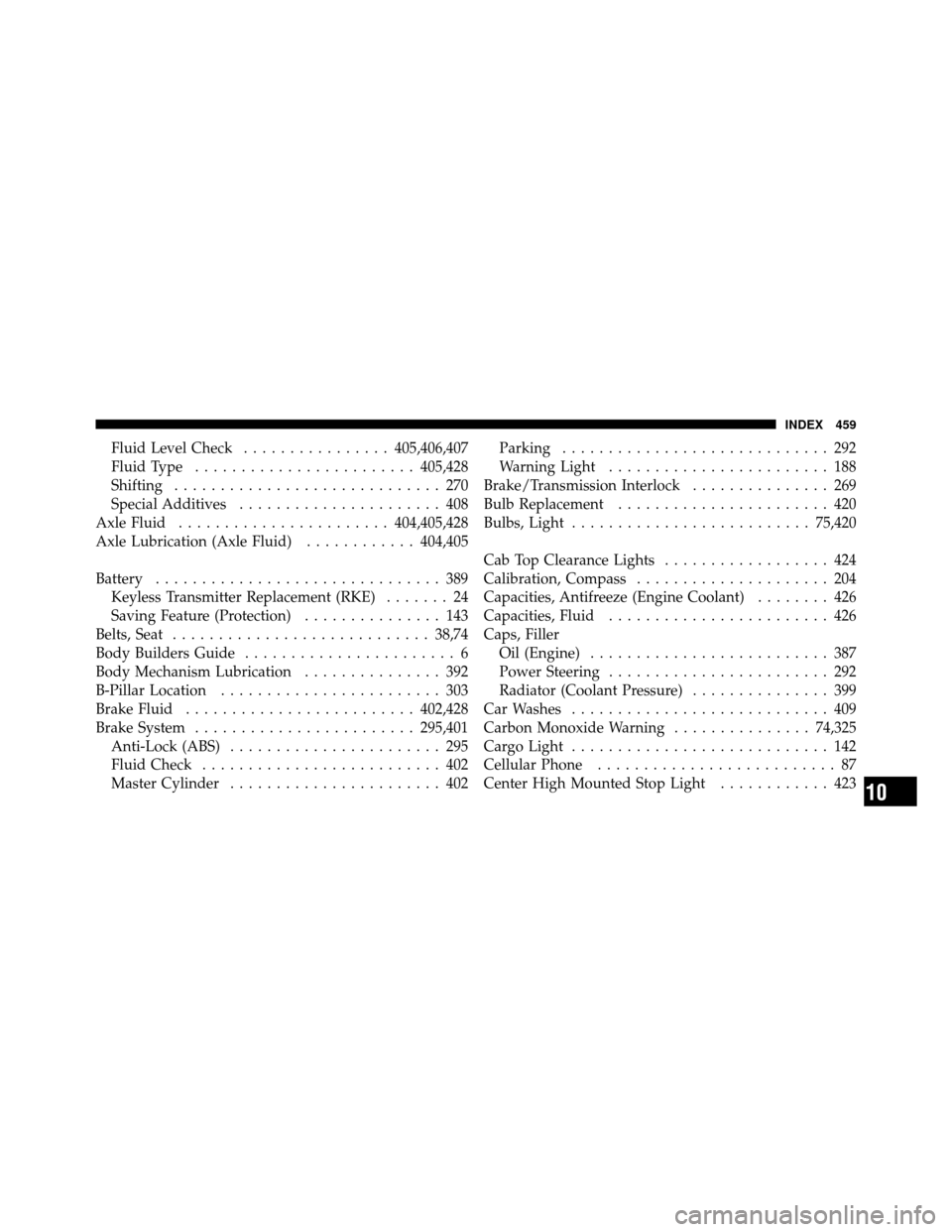
Fluid Level Check................ 405,406,407
Fluid Type ........................ 405,428
Shifting ............................. 270
Special Additives ...................... 408
Axle Fluid ....................... 404,405,428
Axle Lubrication (Axle Fluid) ............404,405
Battery ............................... 389
Keyless Transmitter Replacement (RKE) ....... 24
Saving Feature (Protection) ............... 143
Belts, Seat ............................ 38,74
Body Builders Guide ....................... 6
Body Mechanism Lubrication ............... 392
B-Pillar Location ........................ 303
Brake Fluid ......................... 402,428
Brake System ........................ 295,401
Anti-Lock (ABS) ....................... 295
Fluid Check .......................... 402
Master Cylinder ....................... 402 Parking
............................. 292
Warning Light ........................ 188
Brake/Transmission Interlock ............... 269
Bulb Replacement ....................... 420
Bulbs, Light .......................... 75,420
Cab Top Clearance Lights .................. 424
Calibration, Compass ..................... 204
Capacities, Antifreeze (Engine Coolant) ........ 426
Capacities, Fluid ........................ 426
Caps, Filler Oil (Engine) .......................... 387
Power Steering ........................ 292
Radiator (Coolant Pressure) ............... 399
Car Washes ............................ 409
Carbon Monoxide Warning ...............74,325
Cargo Light ............................ 142
Cellular Phone .......................... 87
Center High Mounted Stop Light ............ 423
10
INDEX 459
Page 461 of 476
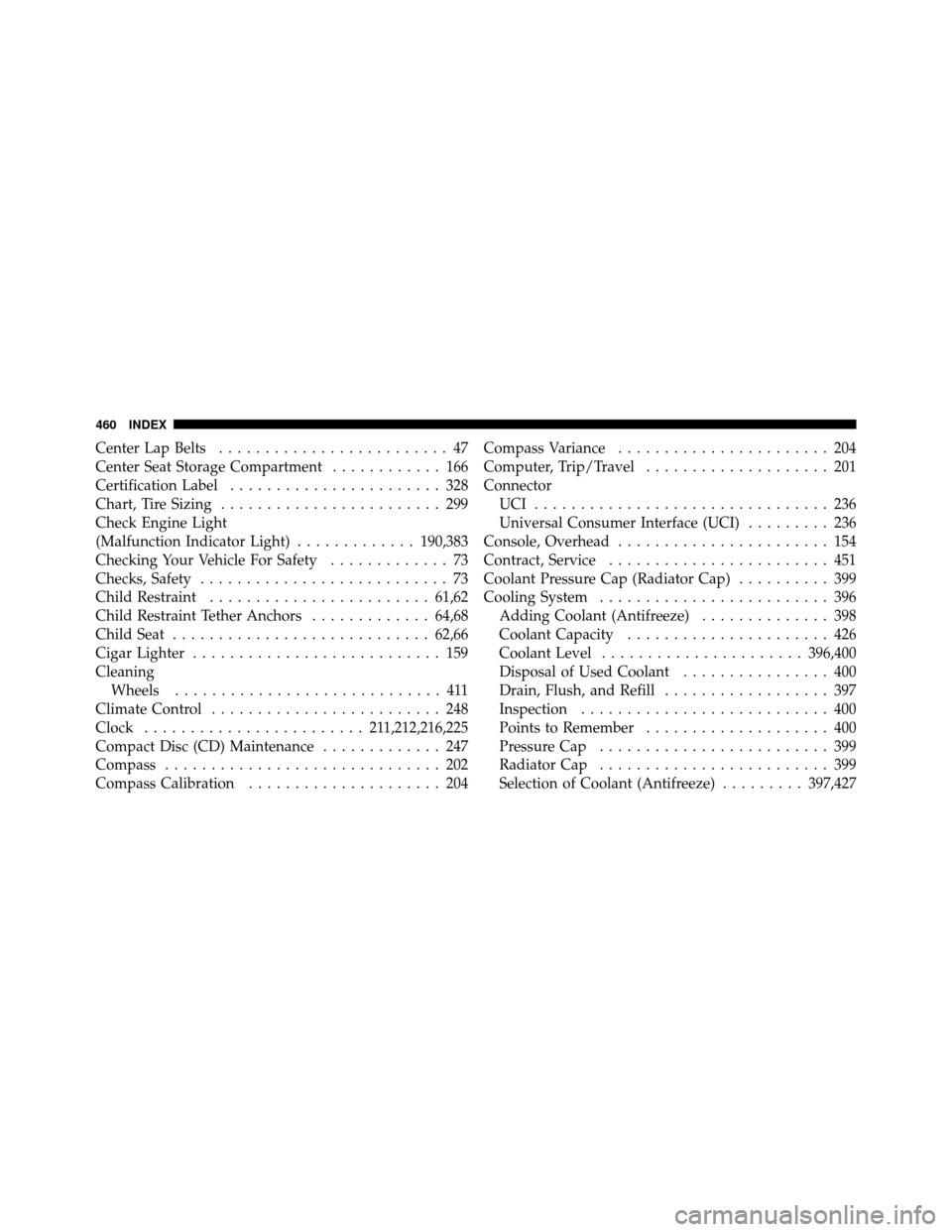
Center Lap Belts......................... 47
Center Seat Storage Compartment ............ 166
Certification Label ....................... 328
Chart, Tire Sizing ........................ 299
Check Engine Light
(Malfunction Indicator Light) .............190,383
Checking Your Vehicle For Safety ............. 73
Checks, Safety ........................... 73
Child Restraint ........................ 61,62
Child Restraint Tether Anchors .............64,68
Child Seat ............................ 62,66
Cigar Lighter ........................... 159
Cleaning Wheels ............................. 411
Climate Control ......................... 248
Clock ........................ 21 1,212,216,225
Compact Disc (CD) Maintenance ............. 247
Compass .............................. 202
Compass Calibration ..................... 204 Compass Variance
....................... 204
Computer, Trip/Travel .................... 201
Connector UCI ................................ 236
Universal Consumer Interface (UCI) ......... 236
Console, Overhead ....................... 154
Contract, Service ........................ 451
Coolant Pressure Cap (Radiator Cap) .......... 399
Cooling System ......................... 396
Adding Coolant (Antifreeze) .............. 398
Coolant Capacity ...................... 426
Coolant Level ...................... 396,400
Disposal of Used Coolant ................ 400
Drain, Flush, and Refill .................. 397
Inspection ........................... 400
Points to Remember .................... 400
Pressure Cap ......................... 399
Radiator Cap ......................... 399
Selection of Coolant (Antifreeze) .........397,427
460 INDEX
Page 463 of 476
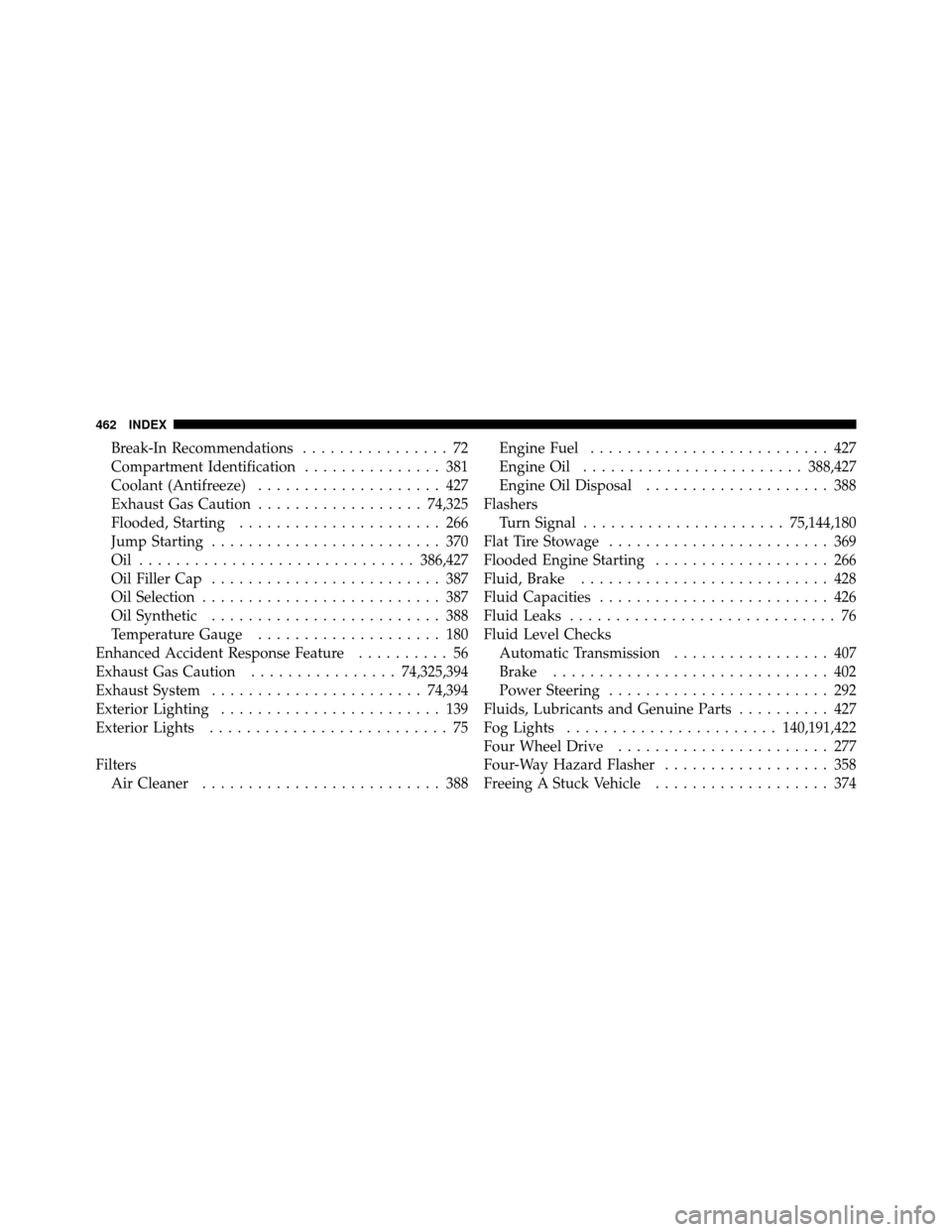
Break-In Recommendations................ 72
Compartment Identification ............... 381
Coolant (Antifreeze) .................... 427
Exhaust Gas Caution .................. 74,325
Flooded, Starting ...................... 266
Jump Starting ......................... 370
Oil .............................. 386,427
Oil Filler Cap ......................... 387
Oil Selection .......................... 387
Oil Synthetic ......................... 388
Temperature Gauge .................... 180
Enhanced Accident Response Feature .......... 56
Exhaust Gas Caution ................74,325,394
Exhaust System ....................... 74,394
Exterior Lighting ........................ 139
Exterior Lights .......................... 75
Filters Air Cleaner .......................... 388 Engine Fuel
.......................... 427
Engine Oil ........................ 388,427
Engine Oil Disposal .................... 388
Flashers Turn Signal ...................... 75,144,180
Flat Tire Stowage ........................ 369
Flooded Engine Starting ................... 266
Fluid, Brake ........................... 428
Fluid Capacities ......................... 426
Fluid Leaks ............................. 76
Fluid Level Checks Automatic Transmission ................. 407
Brake .............................. 402
Power Steering ........................ 292
Fluids, Lubricants and Genuine Parts .......... 427
Fog Lights ....................... 140,191,422
Four Wheel Drive ....................... 277
Four-Way Hazard Flasher .................. 358
Freeing A Stuck Vehicle ................... 374
462 INDEX